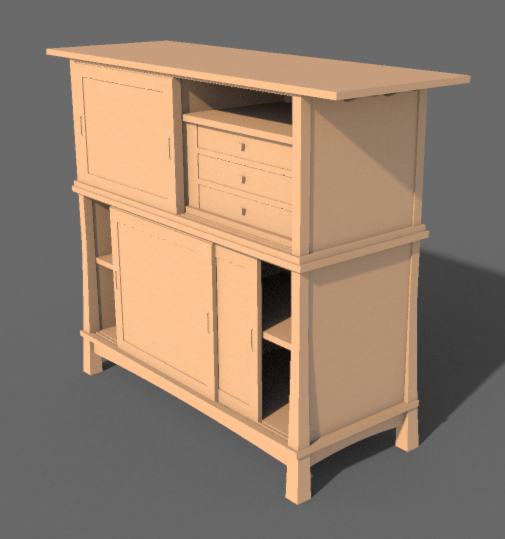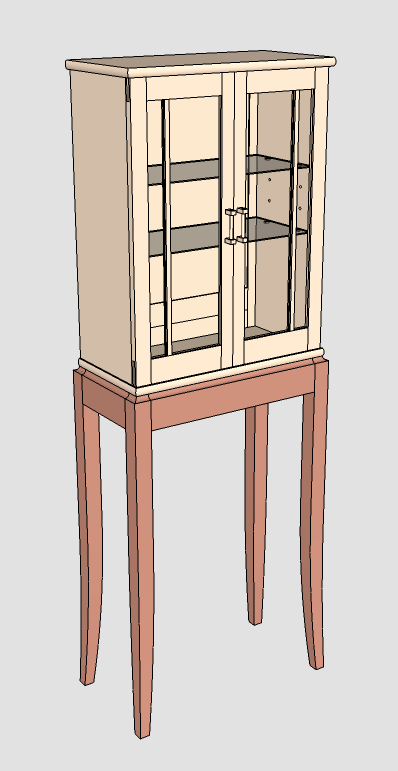Cool.
What does the stretcher on the bottom connect to?
Posts
-
Another Krenov-style cabinet
I think I now have my fill of Krenov-style cabinets. This is one built by James Budlong, who studied with and taught alongside Krenov at College of the Redwoods. It was featured in a 2009 issue of Fine Woodworking magazine, published shortly before Krenov's death.
I took a few liberties with the back panel and the shelf support pins. I also omitted fussy little spring catches for the doors.
Best,
dh
-
RE: My new desk (someday, I hope)
Peter,
As far as I know, the style originated in the South. I've seen numerous variations on the basic style of a cupboard parked on a table. The cupboard usually has a crown, which can be minimal or large, plain or fancy, probably depending on the whim of the cabinetmaker.
Looking at the piece again, I agree that the legs look a little fat. I could slim them down to 2-1/2" square without any trouble.
And, yes, I could use a desk like this even though I'm a slob, too. I like shelves and cubbyholes, but not drawers.
Best,
dh -
RE: My new desk (someday, I hope)
I tend to follow Tim Killen's advice regarding moldings. (Tim is the author of SketchUp Guide for Woodworkers, from Taunton Press.) Splitting a molding (like the crown on my plantation desk) adds to the complexity of the model without making it any easier to construct the real thing in the shop. The important aspects of the molding are its profile and size; the lengths of individual pieces really don't matter much.
There are two exception, though. One, if a piece features an elaborate molding made up of several different pieces, then it would make sense to model each piece separately. Two, if the piece is something other than rectangular--six-sided, or has sides joining at something other than 90 degrees, then it would make sense to model the sticks of molding separately to document the correct miter angles. -
Has anyone noticed something odd about the 3D Warehouse?
I have several models on the 3D Warehouse, and I noticed recently that the data for views and downloads has not been updated since Feb. 26. Is this a change on Trimble's part, to update the data weekly, rather than daily?
Thanks,
dh -
My new desk (someday, I hope)
plantation desk.skpThe desk I now use is a beat-up secretary that we bought (very) used a half-dozen years ago. I'd love to replace it with a plantation desk, a type I've always liked. This one is the same overall height and width of the secretary, but tailored to the stuff I need to shelve.
It's probably a pipe dream to think that I'll ever get this built. But hey, a guy can always hope.
Let me know what you think of the model. Thanks.
dh -
RE: A Little Hall Table
Very nice indeed. The three panels on the door make a excellent touch.
-
RE: A Krenov-inspired sideboard
Yes, the legs have two straight faces (on the inside) and two curved faces (on the outside). Janofsky made a template for the curve from MDF and used it as a story stick--he marked it where the leg had to be cut in sections for the case tops and bottoms. He rough-cut the legs on the bandsaw, then cleaned up the curves with a sander, scraper, and planes.
Making the inside faces of the legs straight is the only practical way to make a piece like this. Trying to mate a curved side piece to a curved leg is not a recipe for success. -
RE: A Krenov-inspired sideboard
Thanks, Dave.
The 1999 Fine Woodworking article had lots of drawings but not enough dimensions, so I had to make up a lot of stuff for the model. Except for the doweling, the joinery is pretty straightforward. Janofsky made the legs the full height of the piece, then sawed them into sections, removing the same amount of material as the top and bottom of the carcases. Your eye sees the smooth curve, even though it's interrupted by the cases. Very cool. He used white oak for most of the piece, with Port Orford Cedar for the door panels.
As I said, I think there are better ways to make the cases than with dowels. You could use wedged mortises top and bottom and cover the through mortises on the top with veneer.I worked with Janofsky once on an article for Fine Woodworking. At the time, he had a smallish shop in a building on the old Alameda Air Station, in Oakland. His shop had been an engine-testing room for the Navy. The walls were very thick solid concrete, the door was equally massive. No windows. That's because the Navy would run aircraft engines at the red line until they exploded. I called the place the Bat Cave.
-
A Krenov-inspired sideboard
 Just finished modeling a small sideboard designed and built by Seth Janofsky several years ago. It was featured in a 1999 issue of Fine Woodworking magazine. For those who don't know, Janofsky is a graduate of the College of the Redwoods program founded by James Krenov; he now works as a cabinetmaker in the San Francisco area. I've watched Janofsky work, and he's an amazing designer and craftsman.
Just finished modeling a small sideboard designed and built by Seth Janofsky several years ago. It was featured in a 1999 issue of Fine Woodworking magazine. For those who don't know, Janofsky is a graduate of the College of the Redwoods program founded by James Krenov; he now works as a cabinetmaker in the San Francisco area. I've watched Janofsky work, and he's an amazing designer and craftsman.
You can easily see the Krenov influences in this design: thin carcase pieces, flared legs, perfect proportions. The joinery is a combination of clever and crazy. The piece consists of a base and two separate cabinets; the case sides are doweled to the tops and bottoms (a typical Krenov detail); there are small changes in dimensions from one case to the next, creating nice shadow lines. But if it were up to me, I'd have used wedged mortises to join sides to bottom and a housed sliding dovetail to join sides to top. Small brackets to support the top are held with a dovetail in the side.
The drawer section is a separate, removable piece. It doesn't show well in the render, but the drawer sides join the front with half-blind through-tenons, another crazy detail.
Still, the piece is quite attractive, and the modeling was something of a challenge. I'm not sure all the dowel holes align perfectly, despite my best efforts. And I ran out of steam before I modeled the pegs to hold the adjustable shelves in place. This is also an early stab at rendering in Shaderlight.
dh -
RE: A Little Wall Cabinet From the Early 1900s
Dave,
Would it work to create a texture in Photoshop, setting the opacity to make it nearly transparent, then importing it into SketchUp? Or would the transparency disappear once it's imported?
Best,
dh -
RE: A Little Wall Cabinet From the Early 1900s
Dave,
We seem to think alike. There's a very similar wall cabinet in "Mission Furniture: How to Build It," by H.H. Windsor. I adapted it last fall to use as a project for a SketchUp training class I was leading. (I'm not fond of wedged through-tenons.) It made a good project for people who have already dipped their toe in the SketchUp water. The book has plans for a number of interesting pieces, including a nice, small slant-front desk.
Best,
dh
-
RE: Tenth time is the charm
Dave,
Gotta love those nits. Good catches.
Best,
dh -
RE: Tenth time is the charm
Michael,
I doubt that I'll build one. Modeling the stretchers was enough of a challenge for me. (And truth be told, I think Gary Rogowski has made better-looking pieces.)
Best,
dh -
Tenth time is the charm
Decided to try my hand at modeling a unique stool first made by Gary Rogowski, founder of the Northwest Woodworking Studio, in Portland, Oregon. Japanese furniture and the work of James Krenov heavily influenced Gary's design, which has curved, splayed legs and stretchers with angled shoulders for the tenons. Modeling the stretchers and the through mortises in the legs was a major challenge. But I think I came pretty close on the tenth try. A couple of the tenons still don't fit as snugly as they might, though.
Let me know what you think.
Best,
dh
-
RE: A Limbert-Style Side Table
Dave,
Nice work all around. How about a few details on how you modified the original design: Scaling? Using the Move/Copy Tool to resize the legs and stretchers? Inquiring minds want to know.
Best,
dh -
RE: Section plane visibility
Can you associate the section plane with a new layer, then set up a scene showing that layer?
-
RE: Lengthen a tapered tube
You may need to redraw the tube using a plug-in like Curviloft.
 A little image
A little image